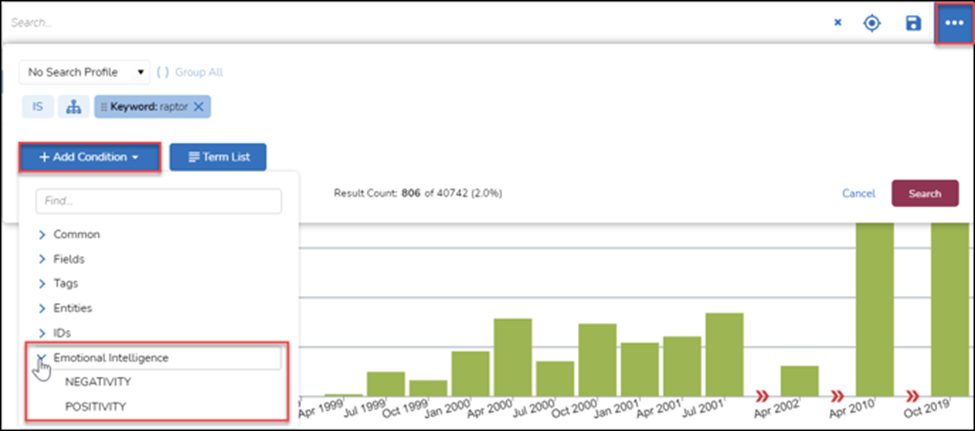What Is Sentiment Analysis?
How Reveal Brings Powerful Tech That Lets You See Beyond Words and Phrases
When it comes to written communications, the truth is often more than meets the eye. Our written exchanges are often oozing with sentiment. Aka the emotional weight behind our choice of words or expressions.
Now, imagine being able to dissect and analyze sentiment in legal documents - it would be a game-changer, right? It'd open a whole new world of understanding actions and motives. Identifying and analyzing sentiment vastly improves our understanding of actions and motivations.
Well, guess what this is not in the realm of sci-fi, Reveal-Brainspace has been getting into the feels for a decade! Sentiment Analysis, or occasionally opinion mining uses Natural Language Processing (NLP) and machine learning to uncover the feeling beyond text.
Reveal's Sentiment Analysis focuses on understanding sentiment not just in what people say, but how they say it. Our AI platform has its own emotional intelligence. Enhancing your ability to find and analyze sentiment in electronically stored information (ESI). Helping to connect the dots and uncover relevant information quickly in a way that keyword search alone cannot do.

Reveal Gets All The Feels
At Reveal, we're all about the feels. We want to know not just what people say, but how they say it.
So, how does Reveal's Artificial Intelligence (AI) work its magic?
It's simple. We use unsupervised machine learning algorithms and NLP to uncover seven types of sentiments or emotional indices in a data set:
🎯 Intent: Eyeing someone's goals or objectives like, "I'm on it!"
🚪 Opportunity: Scoping out those perfect moments for action, "I got this!"
💪 Pressure: Identifying attempts to sway, nudge, or coerce, "You gotta do this!"
🎭 Rationalization: Uncovering reasons and justifications, "No worries, because..."
🎢 Sentiment Shifts: Detecting subtle mood swings and discomfort – think lie detectors, but cooler!
😊 Positivity: Highlighting the bright side, optimism, and virtual high fives!
😢 Negativity: Shedding light on the not-so-sunny chats, unveiling conversations about challenges.
Each chunk of content gets a sentiment score for each of these indices, and then this data point is searchable within the Reveal platform. You can search for any combination of the first four groups (Intent, Opportunity, Pressure, and Rationalization) along with either Negative or Positivity.

- Unscored (palest) - documents such as images which offer no text for analysis and scoring.
- Neutral (0) - documents which do not score mildly or strongly for one of the emotional indices. Like numerical spreadsheets or programming code or bland correspondence.
- Low (1 - 3) - documents scored mildly for one of the emotional indices.
- Medium (4 - 6) - documents scored moderately for one of the emotional indices.
- High (7 - 10) - documents scored highly for one of the emotional indices.

All the eDiscovery Feels
All the feels can bring powerful insights on a wide variety of use cases in eDiscovery. With the massive data volumes today, AI tools like to Reveal capitalize on sentiment analysis to connect the dots quickly.
Categorizing or prioritizing custodians or specific communication based on sentiment indicators can accelerate legal professionals’ decision-making. Reducing the amount of data, the requires human review and helping the legal team uncover relevant documents faster.
Let's explore six specific use cases in the legal industry for Reveal's powerful sentiment analysis for electronic discovery or document review.
- Employment Litigation: Identify instances of workplace hostility, discrimination, or harassment by categorizing and evaluating internal communication (unstructured data) based on positive, negative, or neutral emotions. This allows legal teams to focus on relevant content and uncover key evidence to support or refute claims.
- Contract Disputes: Examine communication between parties during negotiations. By detecting negative sentiments or sentiment shifts, it pinpoints moments of disagreement or miscommunication that could have contributed to the dispute, making it easier to identify the root cause. Bubbling up likely relevant data in the dispute.
- IP Theft & Trade Secrets: Sentiment analysis can detect shifts in communication around the time of alleged theft. By highlighting negative sentiments or unusual patterns(anomalies), it can potentially reveal motives or attempts to cover up illegal activities, providing valuable evidence for investigation.
- Merger & Acquisition Due Diligence: Evaluate company culture compatibility by analyzing sentiments in internal communications. By identifying patterns of positive or negative emotions, it helps foresee potential clashes and supports a smoother transition during a merger or acquisition. Sometimes the semantics make a big difference.
- Insider Threat Detection: Insider threats are a major cyber risk vector. Sentiment analysis can help monitor employee communications for unusual sentiment patterns, negative emotions, or sudden changes that might indicate a security risk or disgruntled employee. By detecting these anomalies, organizations can take proactive steps to mitigate potential risks.
- Social Media Reputation Analysis: In this scenario, sentiment analysis assesses public sentiment toward a company or its products by evaluating emotions expressed in social media content. This enables companies to identify potential PR crises, customer dissatisfaction, or areas for improvement, and make informed decisions based on public perception.
Reveal-Brainspace empowers legal professionals and organizations to uncover hidden insights more efficiently. Stay inspired, LegalTech crew, and keep exploring the amazing potential of AI in our world!
And there you have it! Sentiment analysis with Reveal-Brainspace is like having superpowers to unveil hidden insights. Stay inspired, LegalTech crew, and keep exploring the amazing potential of AI in our world!

Getting Sentimental in eDiscovery
In the eDiscovery workflow, you do not necessarily want to start with sentiment analysis. When it comes to unearthing emotional signals, it's best to kick off with the eDiscovery process with key players and then dive into sentiment.
Narrowing down the inputs and applying sentiment analysis in conjunction with other types of AI or Active learning or technology assisted review (TAR) uncovers relevant data faster.
An eDiscovery workflow using sentiment analysis might look something like this:
- Use sentiment analysis to sort through the data, separating the positive 😊, negative 😢, and neutral 😐 content
- Focus on negative sentiment content to identify patterns of hostility, discrimination, or harassment
- Pay attention to sudden sentiment shifts in conversations. These might signal the moments when the hostility occurred
- Look for rationalizations, pressure, or attempts to persuade the alleged victim to downplay the situation or avoid reporting it
- Review the potentially relevant data and determine if it supports or refutes the matter at hand

And voila! Sentiment analysis saves the day by swiftly sifting through the haystack, helping you find those crucial needles of relevant data. Sentiment analysis is a powerful tool that every legal professional should have in their eDiscovery toolkit.

